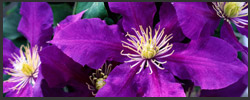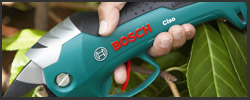YOU ARE HERE Garden answers > Trees & tree growing
Trees
Help solve your gardening problem. Here are the answers to some commonly asked gardening questions about trees with hints, tips and advice.
If you are unable to find the answer here, then send me an e-mail
The cold winter weather has damaged my cordyline palm. Is it dead and what should I do if it is still alive?
I've had lots of e-mails on the same subject, and cordylines have been badly hit across the country this winter.
If the growing point (where the foliage emerges from the main stem) has been damaged, then the top of the palm will die - or is already dead. But all is not lost! You can perform a rescue by cutting down the main trunk to a suitable height – say 3-5ft – below where the main trunk may be dead or rotten, and you should get two or three new growth points emerging directly from the stem at this point. If you leave these, they will all grow to produce a multi-headed effect; you could rub out all but one of the buds as they develop to try and produce a single headed tree again, although most people like the multi-headed effect.
The time to do this is April/May, whenever the weather starts to improve and temperatures start to rise, but leave well alone until you do or don’t see any signs of live – this could be as late as late May/early June.
After cutting through the main stem, it pays to seal the cut – sealing wax or ordinary wax will be fine. Then give the tree a bit of a feed with a general granular fertiliser.
As to whether it is still alive, all depends on how far down the cold/frost has reached, so keep your fingers crossed!
A lot of people have noticed a pink/white fungus on the trunk together with a foul smell, which is due to the main trunk rotting caused by bacterial slime flux. The bacterial ooze can be scrubbed off to reduce the smell, but the ooze cannot be stopped and there is no cure for it.
This probably means that the trunk has completely rotted and so is dead. If it’s soft/rotted all the way through down to ground level, then it has died. If the soft/rot stops at any height above ground level then you can cut down the trunk to this height and deal with it as described above.
If the trunk is completely dead, not all is completely lost as cordylines will often re-shoot from below ground level, but obviously will take several years to reach their former glory.
Last spring I purchased a young flowering cherry. The buds have never opened - is it dead?
If you mean that no leaves have been produced, then I think the answer is yes!
Some plants can take a while to get established, but this seems a long time for a cherry. The best way of telling for sure is to gently scratch the bark with your thumbnail; if there is green tissue underneath then the tree is still alive; if it is brown then it is dead. Start at the tips of shoots and work your way down until you know the extent of how much of the tree (if any) is still alive.
If it is dead then I would take it back to where you bought it and ask for a replacement. Most good nurseries and garden centres have a plant guarantee. Us gardeners never complain enough!
I have a tree stump sawn off at ground level that I would like to remove without digging. What is the best way of doing this?
Tree stumps that are still alive can be killed with SBK Brushwood Killer or one of the glyphosate-based tree stump killers. Make cuts in the bark and apply the chemical to these, as well as drilling holes in the stump and applying more of the chemical. It will take several months to completely kill off the stump.
If you want a quicker result you can use a machine called a stump grinder, which will remove it in seconds. These can be hired from good hire shops or you could call in an approved contractor.
If you're looking for an approved contractor to grind out the stump for you, visit the StumpBusters website.
The easiest way of physically removing a stump is not to cut it down to ground level, but to leave several feet above ground. This will give you something to help lever out the trunk or you could tie a rope to it and drag it out; winches are also available to hire for such purposes.
Why haven't trees that I bought in the autumn taken very well? They were bought from the 'bargain basement' section of a garden centre.
It looks like the trees must have been seriously potbound before you bought them - many 'bargain' trees tend to be in this condition.
It would be better to buy trees that hadn't been sitting around in pots for so long or, better still, buy bare-rooted trees in the autumn.
Always tease out the roots of any container-grown trees or shrubs that look slightly pot bound. This is essential to ensure the roots are encouraged to grow out into the surrounding soil.
Also soil improvement is essential to ensure the roots get the encouragement they need to grow out into the soil.
I have a Catalpa that is about 2m high;, it has already been 'stopped' to make it form a pollard. I intend to keep it pruned to keep it small, but if I do this will there ever be any chance of it flowering?
As we're always told - you can't have everything!
Hard pruning of catalpas in April is essential to keep the plant within bounds and to improve the size and colour of the foliage.
However, it will affect flowering. Having said that I have seen pollarded trees flowering very well. But it is essential that the weather is warm to promote flowering whatever you do, and it takes a few years for catalpa to get into a regular flowering mode anyway.
A friend of mine has lost her grandmother and would like to plant a tree in her memory. She wants to plant a tree that has the name May or Mary (or even Nan). Where do I look for the names of trees? Can you help?
Autumn through to early spring is a perfect time to plant a tree. The only thing that will stop you planting is if the soil is frozen solid or if it is waterlogged.
Hawthorns (varieties of crataegus) have the common name of May blossom - because that's when they flower - and would make an excellent choice.
I cannot find any other trees with any of those names. One of the easiest ways of finding a plant with a specific name is to use the RHS Plant Finder.
I will be be receiving 10 bare-root red maple trees that are approximately 60-90cm (2-3ft) high in early spring. What is the best way to plant them?
First, I'd say make sure you plant them as soon as they arrive; depending on the weather I'd prefer to get these plants in during Feb/March. The only thing that will stop you planting is if the soil is frozen solid or if it is waterlogged.
Put the roots in a bucket of water for about 30 mins before planting to ensure they are thoroughly wet through.
Dig over an area of about a sq yd for each tree and incorporate as much well-rotted compost, manure or leafmould down to a depth of around 45cm (18in).
Dig a hole big enough to take the roots without bending them and deep enough so that when planted the trees are at the same level as they were growing in the nursery. There will be a mark on the stem to show this. Add some more compost and work this into the base of the hole.
Trim off any damaged roots.
Put a stake in the hole.
Plant carefully working a soil/compost mix in between the roots so there are no air gaps. Gently firm down with your heel. Attach tree to stake using two ties.
Water in thoroughly and keep the soil moist for the first summer.
That's all there is to it!
We have a very large flowering cherry, which has been happily growing and flowering for over 20 years. In spring, we noticed that a part of the tree was very poorly leafed and at bloom time that same part of the tree flowered poorly.
Examination of the leaves did show some leaf shot but probably no more than we have seen year after year. The tips of the poorly leafed branches do appear to have the tiny buds but in addition there is also some smaller offshoot branches that appear dead.
I am unsure whether we should be pruning this part of the tree or not. Any suggestions as to what might be the cause? The rest of the tree is in good health and did flower freely and was well leafed all summer.
It sounds like your tree is suffering from bacterial canker. This is a severe and destructive disease which may kill the tree in time. It has become much worse in recent years due to droughts and dry weather which have stressed and weakened the trees.
There are several symptoms that you will notice. First, is shot hole disease which produces small brown spots on the leaves. As the spots grow they fall out leaving a series of holes that look like the leaves have been hit by shotgun pellets.
The more serious symptoms are cankers occurring on the bark. At first they appear as shallow depressions bearing amber coloured gum, but later enlarge and exude large amounts of gum. Affected branches soon die back after yellowing or stunting of the leaves.
You could try pruning out affected branches - cutting at least 15cm (6in) beyond the dead wood and into sound wood; this should not be done now as the wounds are sites for further infection - wait until April . Unfortunately, there isn't a cure for bacterial diseases, but spraying with Bordeaux mixture in mid-August, two weeks later and again in October may help reduce the bacteria. But, more often than not, the tree will slowly die right back and will eventually have to be removed.
Bacterial canker affects both ornamental and fruiting cherries.
Only you will know whether the tree is beyond saving and whether it will need digging up and burning.
If you want to know more, or if there's a gardening topic you're having a problem with and want help and advice, then send an e-mail to: info@gardenforumhorticulture.co.uk


